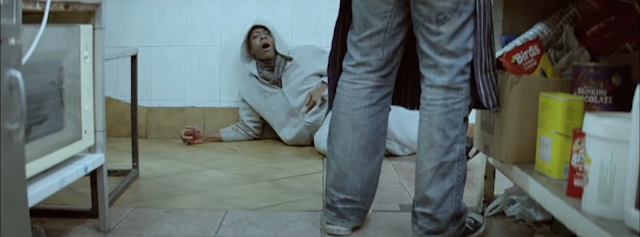The Ellington Kid - Analysis
 |
| A frame from the The Ellington Kid |
The Ellington Kid is a short film directed by Dan Sully, set in a Kebab shop in South London. As Nathan and Beefy eat in the shop, Nathan tells a story about a stabbed youth that too refuge in the same shop after an altercation with a gang.
Mise-En-Scene
Sully shoots on location in South London, so the set of the Kebab shop is a real place. Sully shows all 4 walls of the set to create a sense of realism. The mise-en-scene also acts as a way to create meaning. In the shot above, the counter establishes a physical and metaphorical divide between the gang members and the kebab shop workers, as does their colour-coded costume: The kebab workers in red and the gang members in black.
Performance
The performances aim for realism, with regional accents, a light use of slang and little ham acting. Using specific regional accents and slang is a gamble, as it can often sound unrealistic or overdone. The low-profile castings create realistic characters, as you are not distracted by any big names or recognisable faces.
Editing
The film is intercuts between Nathan telling the story of The Ellington Kid, to flashbacks of what supposedly happened. The cuts start quick, shocking the audience. The flashbacks slowly lengthen as we learn more of the story, with brief cuts to reaction shots from Beefy. The film starts with an intertitle that is reminiscent of Fargo, saying that the film is 'kind of' a true story. This, like a lot of the micro elements, is done to posit the film as an urban legend, not quite true but not quite false.
Cinematography
The kebab shop has stark, bright lighting which contrasts with the grey, dark lighting of the night. This emphasises the shop's status as a safe haven for the Ellington Kid, and reinforces the divide between the shop workers and the gang; the light versus the dark.
Sound
There are three key sound elements in the film: Nathan's voiceover, the score, and the sharpening of the blades. Nathan's voiceover perpetuates the story, he acts as the narrator. His narration over the flashback footage cements the story as a modern folktale; an urban legend. The voiceover makes Nathan an unreliable narrator, which also adds to the sense of an urban legend. As the tale continues, and the flashback segments lengthen, Nathan's voiceover drowns out and the volume of the score increases. This dramatically increases the tension, as the thumping, dramatic score drowns out not only the voiceover but also the foley sound. The score is similar to a heartbeat, so as it increases it emulates a heartbeat increasing due to stress and fear. The last noteworthy sound element is that of the sharpening blades. This sound (and shot) bookends the film. At the beginning it foreshadows the violence, and at the end it hints that Nathan's story might be true - keeping the story in the tantalising grey area between truth and fiction.


well done
ReplyDelete